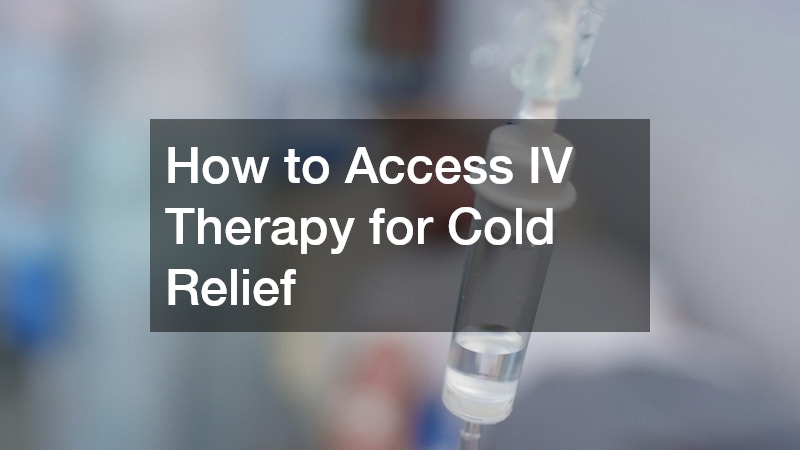As cold and flu season hits, many are turning to innovative solutions like IV therapy for colds to enhance their immune system’s resilience. This trend highlights a shift towards alternative wellness therapies, driven by the desire for rapid relief and prevention of common ailments.
What is IV Therapy and How Does it Work for Colds?
Definition and Mechanism of IV Therapy
Intravenous (IV) therapy involves administering fluids, electrolytes, vitamins, and medications directly into the bloodstream. This method ensures optimal absorption, offering a quicker and more efficient alternative to oral supplements.
In medical contexts, IV therapy has been employed for decades to quickly rehydrate and deliver nutrients to patients. Its use has expanded into wellness and preventive care, including treatment for colds and flu.
Specific Role of IV Therapy in Cold Treatment
When it comes to colds, IV therapy aims to alleviate symptoms by supplying essential nutrients that support immune function. By boosting hydration and nutrient levels, IV therapy can help reduce the duration and severity of cold symptoms.
The rapid delivery of immune-supporting compounds such as vitamin C and zinc directly into the bloodstream is believed to jumpstart the immune response. Although not a cure, IV therapy can be a valuable adjunctive treatment to traditional cold remedies.
Benefits of IV Therapy for Immune System Support
Nutritional Components in IV Therapy
IV drips commonly contain a blend of vitamins and minerals that are critical for immune health, such as vitamin C, B-complex vitamins, and zinc. These ingredients are chosen for their ability to enhance the body’s natural defense mechanisms.
Vitamin C, for instance, is a potent antioxidant that helps protect cells from damage and supports various cellular functions necessary for a robust immune response. The inclusion of these nutrients in an IV drip can provide concentrated doses at levels unattainable through diet alone.
Immediate and Long-term Benefits
One of the most appealing aspects of IV therapy is its capacity to deliver immediate relief from cold symptoms. Patients often report feeling more energized and less encumbered by congestion shortly after receiving treatment.
Beyond instant relief, regular IV therapy may help sustain immune function over time, offering long-term protection against infections. This dual advantage makes it a promising strategy for those seeking comprehensive immune support.
Are There Any Risks Associated With IV Therapy for Colds?
Potential Side Effects
While IV therapy for colds is generally considered safe, some individuals may experience adverse reactions such as allergic responses or vein irritation. These side effects are rare but underscore the importance of professional supervision during treatment.
Additionally, improper administration can lead to complications such as infection or fluid overload, emphasizing the need for qualified practitioners. Patients should always be informed of the possible risks before commencement of IV therapy.
Safety Measures and Guidelines
Ensuring the safety of IV therapy involves following strict protocols, including the use of sterile equipment and precise dosing. Providers must be trained and certified to administer IV treatments safely.
Comprehensive pre-treatment assessments help tailor the therapy to individual needs and mitigate potential risks. Open communication between the provider and patient can further enhance the safety and effectiveness of the treatment.
Who Can Benefit the Most from IV Therapy for Colds?
Ideal Candidates for IV Therapy
IV therapy can be especially beneficial for individuals with compromised immune systems or those who are frequently exposed to pathogens. People with high stress levels and poor dietary habits may also find it advantageous to fortify their defenses against colds.
Athletes and busy professionals, in particular, may benefit from the enhanced recovery and energy boost that IV therapy provides. However, it is crucial for anyone considering this treatment to consult with a healthcare professional to determine suitability.
Contraindications and Precautions
Certain populations should exercise caution when it comes to IV therapy, including those with specific health conditions like kidney disease or heart failure. These individuals are at increased risk for complications and should consider other forms of treatment.
Pregnant or breastfeeding women are also advised to seek medical advice before undergoing IV therapy. Understanding one’s health status and potential contraindications is essential to ensuring safe and effective treatment.
How to Access IV Therapy for Cold Relief
Finding a Certified Provider
Choosing a reputable and certified IV therapy provider is integral to receiving high-quality and safe care. Prospective patients should thoroughly research clinics and professionals, verifying credentials and examining reviews.
Many wellness centers now offer IV therapy services, often under the supervision of medical professionals. Patients should prioritize facilities with a strong track record and rigorous safety standards.
Understanding Costs and Insurance Coverage
The costs of IV therapy for colds can vary considerably, depending on the location, provider, and specific formulation used. While often viewed as an out-of-pocket expense, some insurance plans may offer partial coverage for medically justified treatments.
Understanding the financial implications and potential insurance benefits can help determine the affordability and accessibility of IV therapy. Clear communication with providers regarding pricing and payment options is recommended.


